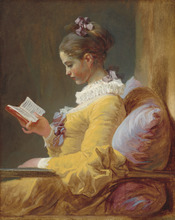The Reader, commonly referred to as A Young Girl Reading is an oil painting by Jean-Honoré Fragonard. Completed in 1776, this "Fragonard favorite" is currently on display at The National Gallery of Art in Washington, D.C. On the surface, the painting seems to be a basic image of a girl with a book but in reality, it is nothing of the sort. In fact, The Reader provides its audience with a very important "snap shot" of 18th century France. This piece is both an exemplary demonstration of how Fragonard's influences affected his individual artistic style and is a classic demonstration of art from the Rococo period.
Fragonard was born in 1732 and grew up to embody the freedom and curiosity of the French Enlightenment. In 1747, at age 15, Fragonard assumed the position of a clerk in the office of a lawyer in Paris and in doing so already broke away from the conventionality of artists of the time who were rigorously bound to the hierarchical structure of the Royal Academy and working for private patrons (Ashton 12).
The lawyer (whose identity is unknown) noticed the young boys aptitude for drawing and advised his parents to apprentice him as an artist. Mme. Fragonard (Jean Honoré's mother) was excited by the prospect of an artistic son and in 1748, Fragonard was taken in by François Boucher (Wildenstein 2). Boucher painted with a brilliance that he strove to make more and more vivid and took it upon himself to not only house Fragonard but actually teach him ideals and methods of painting. Johann Christian Von Mannlich, another of Boucher's students recorded in his journal that once they spent an entire day being taught how "We must not think of a woman's body as a covering for bones" (Wildenstein 3). Lessons like these,



Awesome job!
This essay will be very helpful to me in wirting an essay about how society influenced Fragonard's works. Great information.
1 out of 2 people found this comment useful.